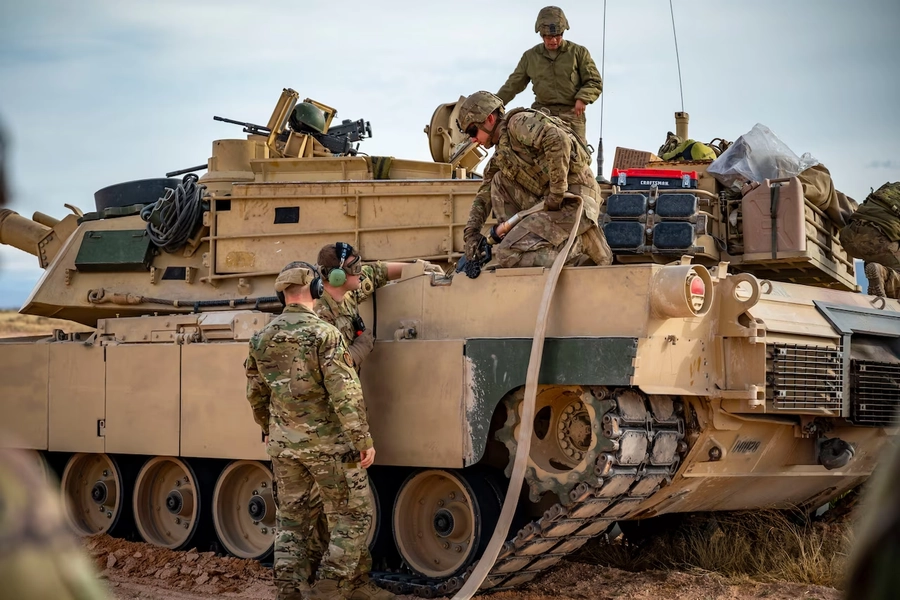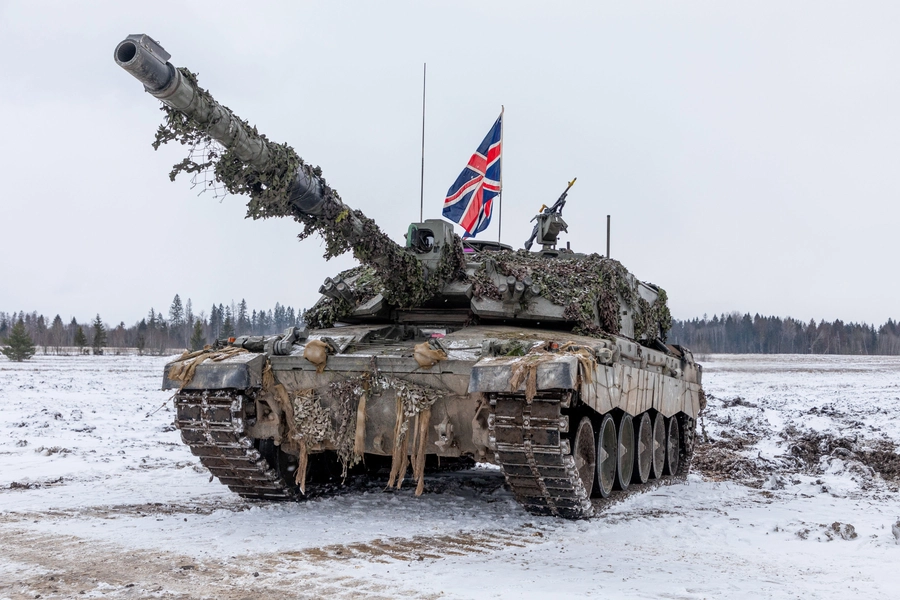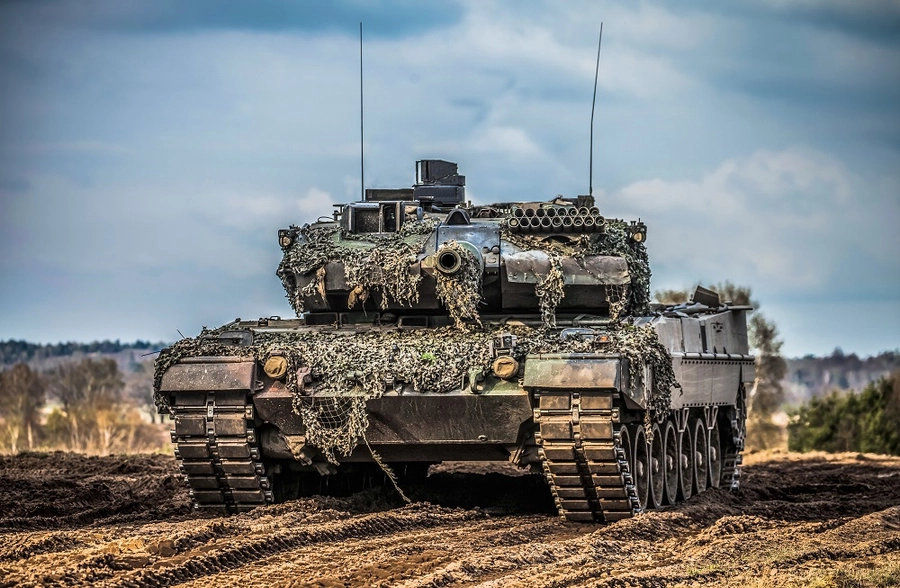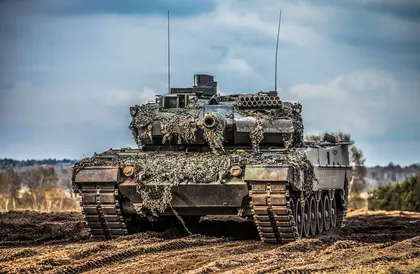By a long shot, the enduring image of a NATO-standard modern main battle tank in the Russo-Ukraine War is a video of a stopped vehicle getting hammered by cheap FPV drones, before it gets set on fire and burns down to a six-million-dollar hulk.
Combat video posted by the 79th Air Assault Brigade on Tuesday, reportedly from the eastern Avdiivka sector, was typical, showing a stationary US-made M1A2 Abrams tank hit with a detonation in the back of the turret, probably by a Russian FPV drone.
JOIN US ON TELEGRAM
Follow our coverage of the war on the @Kyivpost_official.
Three crew hurl themselves from the main battle tank (MBT) as ammunition stored in a bin on the back of Abrams’ turret catches on fire. The vehicle appears to have taken minor damage. Shells inside the ammo bin start cooking off and the blaze spreads to the tank’s hull. Thirty seconds later the American fighting vehicle is burning fiercely and appears well on its way to becoming a total-write off. The fate of the fourth crewman isn’t clear.
When a US-led coalition of Western nations was confronted with Russia’s 2022 full-scale invasion of Ukraine, policymakers and security experts on both sides of the Atlantic debated for months about sending Kyiv modern tanks. The main worries were that maybe Ukrainians couldn’t operate or maintain such modern weapons, or that maybe Ukraine would collapse, or that perhaps Russia might do something aggressive.
With Britain leading the way, Ukraine’s allies sent Ukraine about 120-130 NATO-grade tanks. The first vehicles arrived in April 2023. The hope was Western MBTs would spearhead assaults on Russian defenses. The first serious commitment of NATO tanks against the Russian army took place in June. It didn’t go well, and by October according to open sources, 10 German Leopard 2 tanks had been knocked out for zero Ukrainian battlefield gains.

Diane Francis Interviews Mikhail Zygar, Yaroslav Trofimov on Prospects of Russia’s War on Ukraine
Almost a year later, the Ukrainian army mostly uses advanced Western tanks like Leopard 2 as expensive artillery pieces, lobbing shells at the Russians from a long distance. They stay away from the front line.
Mike Riedmuller, a former US Army cavalry officer commanding Abrams tanks in combat in Iraq, in comments to Kyiv Post said that one reason NATO’s best tanks haven’t performed up to expectations in the Russo-Ukrainian War is that cheap drones are so dense over the battlefield that almost any time a tank breaks near the front line, swarms of drones buzz in to attack it.

“Now (in warfare in Ukraine) a mobility kill invites a swarm of cheap drones that can drop grenades show up and change the mobility kill into a catastrophic kill pretty quickly, no artillery needed,” Riedmuller told Kyiv Post.
Of the 31 American Abrams sent to Ukraine, at least five reportedly have been destroyed following the vehicle’s first serious commitment to combat in February. At least three were burnt after having been hit repeatedly by FPV drones in the Avdiivka sector, a Kyiv Post review of the battle video found.
Britain’s Challenger 2 has been praised by crews for excellent ergonomics and highly accurate gunsights and main gun. Both sides generally acknowledge it to be the single most powerful tank operating in Ukraine, probably, and likewise the vehicle most likely to win a tank-to-tank duel.

But tank shootouts in Ukraine engagement are practically unheard of. State-of-the-art optics, depleted uranium armor-piercing shells, a world-beating main gun, thermal sights, wind sensors and fire control computers able to adjust for the rotation of the Earth undoubtedly would make Challenger 2 deadly in a one-to-one fight, but since battles like that aren’t happening much of that kit really is mostly extra weight, some operators said.
“Tank-on-tank engagements were ALWAYS far rarer than many with a vested interest in their branch [armor] would have you believe. You only have to look at the data from NW Europe 1944. Yom Kippur and Desert Storm were slight anomalies but that was dictated by terrain,” Simon Johnson, a former British armor operator, told Kyiv Post. “I think the mistake the Western leaders made was to assume that gifting you [Ukraine] a few of our vehicles [NATO main battle tanks] would allow you to waltz through the Russian lines.”
Fourteen Challenger 2 tanks were assigned to the 82nd Air Assault Brigade, a seasoned formation with top-priority access to the best weapons and equipment available to the Ukrainian Armed Forces (AFU). Operators have said that at 64 tons the tank is too heavy to cross most Ukrainian bridges or cross soft ground without getting stuck, and that spare parts are chronically short. Leopard 2’s weight is similar. Abrams’ is about five tons more.
The first Challenger was burnt in the Robotyne sector in September 2023. Reportedly, the tank was hit by artillery during an attack, stopped moving, and was then set on fire. Two Challengers were operational in mid-March, Sun newspaper reported. MP Grant Shapps told British media on Sept. 6 there were no plans to send replacements.
The most common modern NATO tank in Ukraine is Germany’s Leopard 2. Most are Cold War-era models produced in the early 1990s and priced at the time at about $6 million each. According to the international military data site Oryx Ukraine’s European allies have transferred 82 Leopard 2 tanks, with Germany and Poland kicking in 18 and 14 respectively.

Germany donated 128 Leopard 2 tanks to Poland in 2002. The Polish army found them to be serviceable but expensive to upgrade, and because they were already decades old, increasingly costly to maintain. If the Leopards were used intensively the problem would get worse. There were complicated arguments about repairs with the German manufacturer Krauss-Maffei Wegmann.
Kyiv’s experience with its own Leopard 2 tanks, some literally hand-me-downs of hand-me-downs, has not differed from Warsaw’s. The tank has excellent armor, a powerful gun, excellent optics, and superior crew comfort. The tactical problems come when there is a need to move it. Poland and Germany are wrangling about where and by whom Ukraine-operated Leopards should get major maintenance.
In Leopard 2’s first major commitment to battle, in the Zaporizhzhia sector in June and July, Russian defenders halted Leopard 2s by attacking the tanks’ tracks with mines or less commonly missiles, and then once the vehicle was stopped demolishing it with artillery or helicopter gunships.
Armor experts interviewed by Kyiv Post said that although the Russo-Ukrainian War has shown that modern main battle tanks aren’t as useful as they were thought to be during the Cold War era, they still have their uses. Most pointed to the Ukrainian army’s limited practice of executing combined arms attacks as a reason not to conclude tanks in general are obsolete.
“Yes, tanks are vulnerable at the tracks but there is always a race between weapons that penetrate and disable and the shielding that protects this. When one side gets the edge, that’s where the fight is won. If you don’t have tanks and the other side does, that puts you at a huge disadvantage,” said Ian Healy, a former Challenger gunner told Kyiv Post.
The Ukrainian army since its failed counteroffensive in Summer 2023 has pushed tanks – both NATO-standard and Soviet-era – into attacks only sparingly, and in small numbers. Some units have used tanks in assaults on wood lines, in poor weather. Both sides in urban fights have, from time to time, brought in a tank to blast strong points.
Russian tank commanders still seem willing to commit four or six tanks into an attack at a time, but such assaults come only rarely. Since February 2023 the Ukrainian army has almost always cut up such armored columns by hitting them with artillery when the tanks drive into a minefield and then bringing in more artillery and attack drones.
The bottom line, armor experts interviewed by Kyiv Post agreed, was that the fluid battlefield the modern tanks were supposed to fight and survive in, is a good deal different from the one they face in Ukraine right now.
“Ammunition, more drones, more Bradleys or CV-90s, more artillery, and just about anything else would have been money better spent. That’s obvious in hindsight but wasn’t that hidden from view at the time and the West should have seen it,” Riedmuller said.
You can also highlight the text and press Ctrl + Enter






